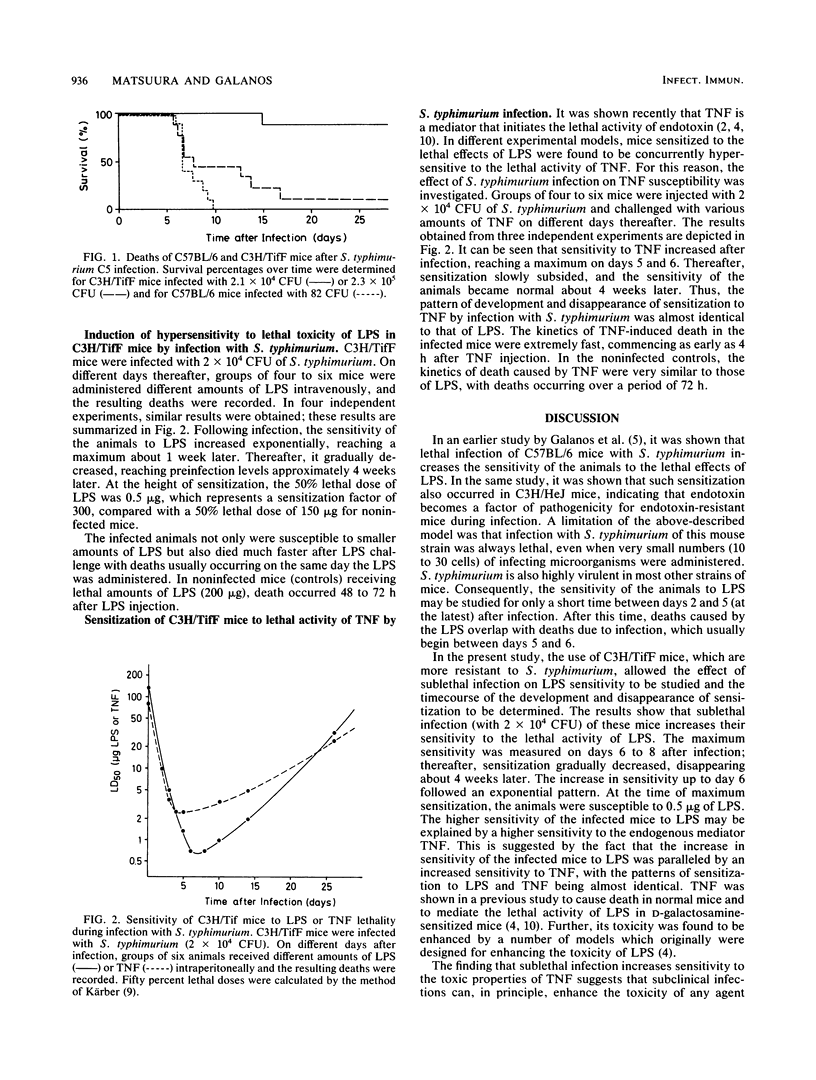Abstract
The effect of sublethal infection with Salmonella typhimurium on the sensitivity of mice to the lethal activity of lipopolysaccharide (LPS) was studied in C3H/TifF mice. These mice are more resistant to S. typhimurium infection and survive inocula that are lethal for most other strains of mice. Infection of C3H/TifF mice with 2 x 10(4) CFU of S. typhimurium was without lethal effect. However, administration of LPS at different times after infection revealed that the sensitivity of the animals to the lethal activity of LPS increased exponentially, reaching a maximum by 6 to 8 days after infection. Thereafter, it decreased, reaching preinfection values about 4 weeks after inoculation. At the height of sensitivity, the animals were susceptible to less than 1 microgram of LPS compared with 100 or 200 micrograms in noninfected mice. The sensitization to LPS by infection was paralleled by a sensitization to tumor necrosis factor. The time course of development of sensitization to tumor necrosis factor, as well as the time course of its decrease and disappearance, was almost identical to that of LPS.
Full text
PDF


Selected References
These references are in PubMed. This may not be the complete list of references from this article.
- BERRY L. J., SMYTHE D. S. EFFECTS OF BACTERIAL ENDOTOXINS ON METABOLISM. VII. ENZYME INDUCTION AND CORTISONE PROTECTION. J Exp Med. 1964 Nov 1;120:721–732. doi: 10.1084/jem.120.5.721. [DOI] [PMC free article] [PubMed] [Google Scholar]
- Beutler B., Milsark I. W., Cerami A. C. Passive immunization against cachectin/tumor necrosis factor protects mice from lethal effect of endotoxin. Science. 1985 Aug 30;229(4716):869–871. doi: 10.1126/science.3895437. [DOI] [PubMed] [Google Scholar]
- Galanos C., Freudenberg M. A., Reutter W. Galactosamine-induced sensitization to the lethal effects of endotoxin. Proc Natl Acad Sci U S A. 1979 Nov;76(11):5939–5943. doi: 10.1073/pnas.76.11.5939. [DOI] [PMC free article] [PubMed] [Google Scholar]
- Galanos C., Lüderitz O., Westphal O. Preparation and properties of a standardized lipopolysaccharide from salmonella abortus equi (Novo-Pyrexal). Zentralbl Bakteriol Orig A. 1979 Apr;243(2-3):226–244. [PubMed] [Google Scholar]
- Lehmann V., Freudenberg M. A., Galanos C. Lethal toxicity of lipopolysaccharide and tumor necrosis factor in normal and D-galactosamine-treated mice. J Exp Med. 1987 Mar 1;165(3):657–663. doi: 10.1084/jem.165.3.657. [DOI] [PMC free article] [PubMed] [Google Scholar]
- SUTER E., ULLMAN G. E., HOFFMAN R. G. Sensitivity of mice to endotoxin after vaccination with BCG (Bacillus Calmette-Guérin). Proc Soc Exp Biol Med. 1958 Oct;99(1):167–169. doi: 10.3181/00379727-99-24282. [DOI] [PubMed] [Google Scholar]
- Schramek S., Kazar J., Sekeyova Z., Freudenberg M. A., Galanos C. Induction of hyperreactivity to endotoxin in mice by Coxiella burnetii. Infect Immun. 1984 Sep;45(3):713–717. doi: 10.1128/iai.45.3.713-717.1984. [DOI] [PMC free article] [PubMed] [Google Scholar]
- Selye H., Tuchweber B., Bertók L. Effect of lead acetate on the susceptibility of rats to bacterial endotoxins. J Bacteriol. 1966 Feb;91(2):884–890. doi: 10.1128/jb.91.2.884-890.1966. [DOI] [PMC free article] [PubMed] [Google Scholar]


